The “Tales of” series marked its 25th anniversary in 2020. The series has come this far thanks to the love and support of its many fans. To commemorate this milestone, we gathered members of production teams who have worked on the “Tales of” series thus far and had them look back over the series’ 25 years of history. We have lots to share; from secret stories of past production told by legendary team members, to future prospects for the series, and the latest information from the current IP general producer.
*This article was originally released in Japan on December 16, 2020.
“Tales of” Series 25th Anniversary “Legends Talk” (Part 2)
“Legends Talk” is a program that looks back over the 25-year history of the “Tales of” series, now available for viewing on the Tales of YouTube Channel on YouTube . As a continuation of Part 1, which presented secret production stories about the storylines and characters as told by the “legends,” Part 2 takes a look at the series’ battle systems, theme songs, and background music. This installment, too, is chock full of tidbits that couldn’t fit into the original program! Here are the legends who appeared in the program!
Here are the legends who appeared in the program!
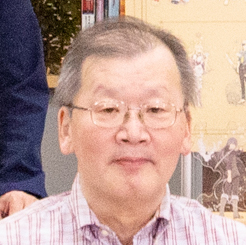
Shinichiro Okamoto

Makoto Yoshizumi
He served as sales promoter from “Tales of Phantasia” to “Tales of Eternia.” After “Tales of Eternia,” he switched to a development producer role, and has since produced titles such as “Tales of Symphonia” and “Tales of the Abyss.” He currently handles rights and promotions at BANDAI NAMCO Sevens Inc.
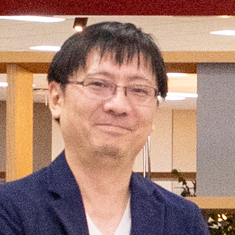
Yoshito Higuchi
After working on production for “SoulCalibur” and “TEKKEN Tag Tournament” series, among other titles, he began participating in the “Tales of” series starting with “Tales of Destiny 2.” Since then, he has served as a director and producer for such titles as “Tales of Symphonia” and “Tales of Vesperia.” He is currently the BANDAI NAMCO Studios studio game design manager.

Tatsuro Udo
He took part in the PlayStation version of “Tales of Phantasia” as a map programmer and he handled both battle programs and planning for “Tales of Eternia.” He also did planning for “Tales of Berseria.” He still works today at BANDAI NAMCO Studios, where he is doing planning for “Tales of the Rays.”
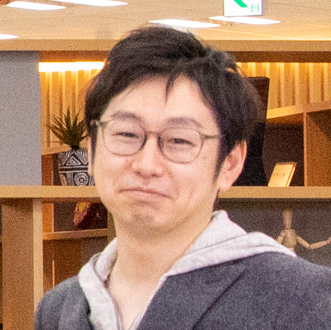
Emcee / Yusuke Tomizawa
Currently the IP General Producer for the “Tales of” series. After working at BANDAI, then transferring to the former BANDAI NAMCO Games, he joined Yoshizumi’s team to help launch the “God Eater” series. He later became involved with the “Tales of” series as a producer, starting with “Tales of Vesperia: Definitive Edition.” presently, he is serving as a producer for the latest title, “Tales of Arise,” as well as supervising the “Tales of” brand overall and leading IP strategy.
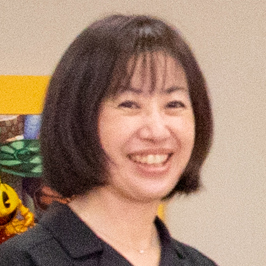
Emcee / Riko Kushida
Freelance writer who wrote the official book on the “Tales of” series. She specializes in video games and cars, among other things. Bird-watching is one of her hobbies.
The astonishing Linear Motion Battle System: “We absolutely had to get this out to players”
Kushida: Starting now, I’d like to ask you about battle systems. Okamoto-san, can you tell us about the origins of the Linear Motion Battle System (hereafter, LMBS) (*1), which came about with the series’ first title, “Tales of Phantasia” (hereafter, Phantasia)?
*1 Linear Motion Battle System: A system where friends and foes battle it out as they move around in real time on a horizontally scrolling screen. The player inputs a command to manipulate the character.
Okamoto: As I mentioned in Part 1, development for the “Tales of” series got its inception with a prototype that was brought over from the software development company Nippon Telenet. The LMBS was included in the demo that was brought over.
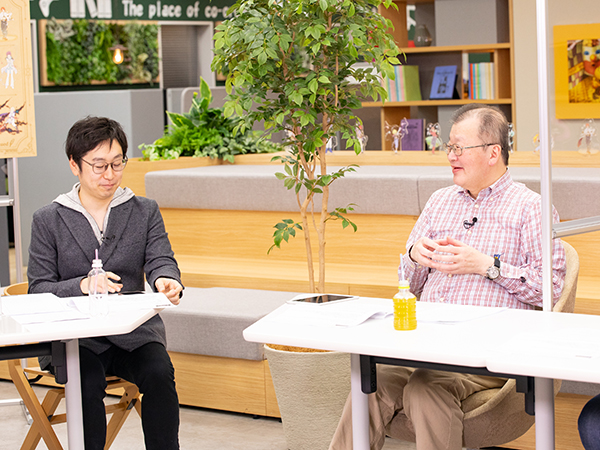
Kushida: In the 1990s, when “Phantasia” was released, it was an extremely innovative system for an RPG, wasn’t it?
Okamoto: It was an ordinary horizontal scrolling screen, but the characters were moving around crammed into a tight space. When I saw the demo, I was surprised. I felt like we absolutely had to get this out to the players. Even though I was so impressed by the LMBS in “Phantasia,” when I saw that the game had further evolved in the third work, “Tales of Eternia” (hereafter, Eternia), I sensed that it was actually the magnificence of the game.
Kushida: Like you’re saying, the battle systems in the “Tales of” series has kept evolving with every title. I’d like to hear what the development side has to say, so the next question is for Udo-san, who developed the battle system for “Eternia.” How did you go about developing the battle system?
Udo: I had taken part in the map program for the PlayStation version of “Phantasia,” but “Eternia” was my first time developing a battle system. For the battles, I checked the screenplay and wrote down all the lines in the battles as I went along. Every once in a while, the screenplay writer would tell me, “This character wouldn’t say something like that,” but I’d push back and say, “No, you’re wrong” (laughs).
Tomizawa: As you move ahead with the development, a picture of the character takes shape among the staff as well. We come to see that this character has this kind of personality, for example.
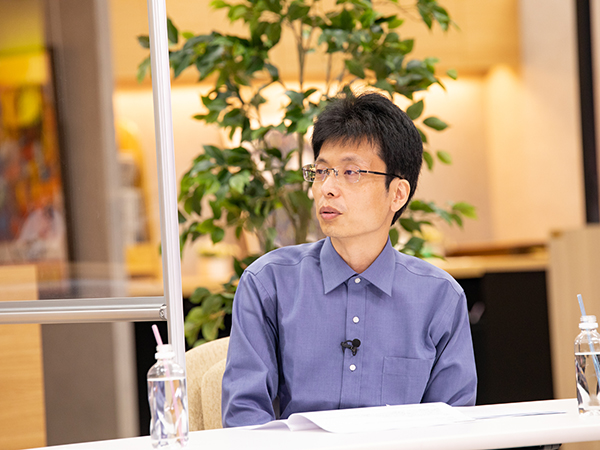
Udo: My involvement was mostly related to the fighting, but in terms of the battle system, I’ve always made arrangements that add excitement to the screenplay.
One thing that was memorable is that in the final boss fight in “Eternia,” I added a feature that people will notice if they follow the story carefully, but one that we couldn’t mention in the system’s explanation. I knew that if players didn’t notice this feature, they would have a pretty tough fight, but I went ahead and put it in because I thought this format would make it the most exciting. It was quite an adventure, but I wasn’t told to change it.
Tomizawa: Nowadays this kind of game system might be rejected for not being user friendly, but at the time, there was a certain element of matching wits against the game.
Okamoto: The final boss battle in “Eternia” was difficult, but when I noticed the feature, I was surprised, and it was fun. In the end, it turned out to be an extremely good format. The traps and the dungeon puzzles were also hard compared to things nowadays.
Tomizawa: The fighting spirit that each team member uses – to bring to life the story and characters that you share with them – probably enriches the games. I realized that all over again as I listened to everyone’s comments.
Evolution of the battle system and its coexistence with the “Tales of” style
Higuchi: What’s amazing about Udo-san is that even as he evolved the battle system with each title, he maintained the signature “Tales of” style. Even the LMBS went through a series of trials and errors with each title, right? In that context, the Style Shift Linear Motion Battle System(*2) that appeared in “Tales of Graces” (hereafter, Graces) blew me out of the water.
*2 Style Shift Linear Motion Battle System: This involves fighting while shifting between two styles, one for each character. There is also a “Free Run” capability that lets you move freely around the battlefield, but it depletes resources so you can’t use it excessively.

Udo: I developed that because I wanted to somehow override the “Free Run” function of the previous title, “Tales of the Abyss” (hereafter, Abyss) (laughs). “Free Run” was too efficient in “Abyss,” so I think in some ways it narrowed people’s strategies. I adjusted the balance in order to have players enjoy the battles using a wider variety of strategies.
Yoshizumi: Adjusting the balance is hard for battles, isn’t it? If you change the operations drastically, you have to have players practice using it, and meanwhile, that “Tales of” style is also necessary.
Kushida: Udo-san was also involved in development for the smartphone style “Tales of the Rays” (hereafter, The Rays). It has its own unique specifications, like flick operations and there are a lot of playable characters; so if you have any war stories from the development process, please tell us about them.
Udo: I only joined in after the system was relatively finalized, but even so, I wanted to make the choreography for the Magic Mirror Arts and I created more than 560 patterns.
All: (Laugh).
Yoshizumi: Gosh, you work hard (laughs)! How do you think up the motions?
Udo: In about 30 seconds, I decide roughly what a character is going to be like. Because that yields better results. Agility is important.

The theme songs brought the “Tales of” series’ world view to life: What led to their adoption?
Kushida: Our last topic will be theme songs and background music.
Tomizawa: Ever since the first title, “Phantasia,” there’s been a theme song, and in the rest of the series, the theme songs have been made in partnership with the artists. Please tell us about how these songs were created.
Kushida: In one of the stories we heard about in Part 1, the demo brought over from the development agency had a song in it with vocals, right?
Okamoto: It was a development sample, so what was on there was a song by an extremely famous artist. When we heard it, all of the staff felt motivated, like there was no way we could forgo adding a theme song. When I discussed it with JVC, who I was working with at the time, they got enthusiastic about it and said, “Let’s do an audition.” Things really took off after that.
Kushida: And the theme song was then passed down as a tradition in the series. The song “Yume de aru you ni” (“Like a dream”) by DEEN, which became the theme song for the second title, “Destiny,” was also memorable. The 1990s was a time when TV anime shows also started using songs by artists and I feel like things flowed with the times in the same way for the “Tales of” series. How did you go about creating the partnerships?
Okamoto: When the development began on “Destiny,” I felt it wouldn’t make it without a theme song, so I was searching for an artist. There were twists and turns in our being able to get DEEN. As far as the background, I went on a business trip overseas with our president at that time, and he said in passing during a car ride, that he was going to be meeting DEEN soon, so I said, “Please introduce me!” And that request is what led to the partnership.
Yoshizumi: DEEN proceeded to write wonderful songs for us every time after that and they worked with us on a lot of collaborations as well.
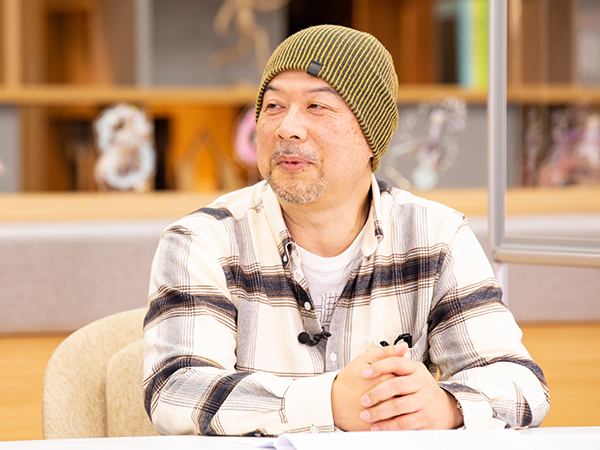
“Karma,” the theme song for “Abyss,” took shape in just 10 days post-meeting
Kushida: Since then, many different artists have worked with you on theme songs. Do you choose them based on auditions?
Yoshizumi: Since “Phantasia,” we have not done any auditions. We just talk with the music management companies about who we should go with next. Then we may put out a request or follow a specific connection — there are a lot of different methods. We always ask according to the circumstances at the time.
Even so, “Karma,” the theme song for “Abyss,” was special. It just so happened that Higuchi-san and I liked BUMP OF CHICKEN (hereafter, BUMP), and we were talking about wanting to ask them [to create a song for us]. But although we wanted to ask them, our advertising agency didn’t have any connections to them. Ultimately, they said, “Their office is right here; would you mind going over and asking them?” (laughs)
According to my memory of the time, I don’t think BUMP had done that many theme songs with games… But anyway, we practically barged into the office unannounced and asked, and they said, “Oh, that sounds interesting” and took us up on it.
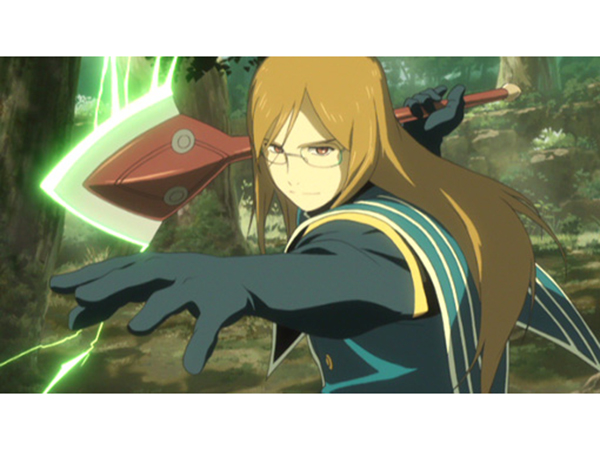
Tomizawa: We have a question from a fan about “Abyss.”
Q. Audio is incorporated as an important element in “Abyss.” Can you please tell us how phonemes (*3) came about?
*3 Phonemes: Elements that make up the world, often seen in fantasy worlds. In the story, there are even scientific techniques that apply phonemes, which are called by that name in the story.
Higuchi: The phonemes are an element that arose when the staff decided that we wanted to do a song battle. We proceeded with that separately from the theme song requests, but when we told BUMP in the process of explaining the game that we wanted to weave songs into the story, the vocalist Fujiwara-san was kind enough to say, “In that case, please let us do it.” And for our part, everything worked out like we wanted, so we said, “Absolutely!”

Yoshizumi: We managed to get the theme song made in quite a short time, didn’t we? After we finished explaining “Abyss” to BUMP twice, I’m pretty sure it took them less than 10 days to make “Karma” for us. I heard from the contact person, who said they’d just finished it and were sending it by email, and when I saw the title, I thought, “This is awesome!” They distilled the information we gave them and the word they came up with was “Karma.” I was surprised at how incredibly perfect it was.
Tomizawa: Incidentally, did the vocalist Fujiwara come up with the line “Discover the meaning of life,” which was also used in the genre name, “Discover the meaning of life RPG”?
Yoshizumi: Of course, their side came up with it. They’re really great words, so we asked them, “Could we use that for the genre name as well?” (Laughs) One time, they came to the development site late at night. Apparently, it was right when the graphic designer Okumura (*4) was eating some cup yakisoba (laughs). When I think about it now, I believe BUMP came so they could show their support for us while we were hard at work.
※4 Daigo Okumura: A graphic designer for BANDAI NAMCO Studios who has been participating since “Eternia”
Tomizawa: On the subject of phonemes, that was like a marriage between the game and the artist, what we could call the ultimate partnership.
Yoshizumi: As to whether we can do the same thing every time, it’s difficult, and it depends on the timing as well. It also comes down to what the artist is interested in and what sort of activities they want to do. That’s closely related, too. I’ve heard that BUMP was also wanting to expand the scope of their activities at that time.
Higuchi: At that time there were few partnerships between games and artists, so I’m often asked, “How did you pull it off?” For our part, we just naively asked and we didn’t have the know-how or the techniques to be able to answer. But it seems that partnerships with games increased after that, so I think it might have played some sort of useful role.
Working with the series’ iconic composers: Sakuraba and Shiina
Kushida: Next, tell us about the background music. The theme song for the Avant Movie(*5) – that Tomizawa-san directed the production of – was done by Motoi Sakuraba(*6), who is well known for his work on the series’ background music.
*5 Avant Movie: A movie created to commemorate the 25th anniversary, symbolizing the entire series. It is being used at a variety of events as an opener for the “Tales” series. “Avant” means “prior to” in French.
*6 Motoi Sakuraba: A freelance composer who has a lot of fans for his battle songs in particular. He has been involved in producing many songs for the “Tales” series’ game music since the early titles.
Tomizawa: I made a brand logo and a concept movie to celebrate the 25th anniversary. I wanted a single, so I asked Sakuraba-san to please create it.
Kushida: On that note, can you tell us what led to the “Tales of” series’ encounter with Sakuraba-san?
Okamoto: I think Sakuraba-san may have originally had a contract with Nippon Telenet. It was fortunate that we were able to call on him starting with the first title of the series. When I listened to the song he gave us for “Phantasia,” there was no way we weren’t going to ask him for the next one, too. If anything, we were a little afraid that he might stop accepting our requests (laughs). That’s how much Sakuraba-san is a figure who has formed the backbone of the series’ production.
Kushida: In terms of background music, it’s an element that’s closely associated with the battles. Udo-san, are there things that you requested?
Udo: Basically no, but when I inserted a hidden character in “Eternia,” I did take the unusual step of making a request. As you advance the battlefield event, Cress from “Phantasia” appears. I thought it would be good to arrange the ordinary battle background music from “Phantasia” for that special moment. Sekundes’ battle in “Eternia,” too, features characters related to the final boss of “Phantasia,” Dhaos, so I had the previous music arranged. Sakuraba-san works fast, so I was very impressed. He made the arrangements for me with no trouble at all.
Kushida: Another composer for the series, Go Shiina (*7), is also famous; do you have any anecdotes involving him?
*7 Go Shiina: A freelance composer with an established reputation for a majestic, orchestral style. He joined the former Namco in 1997, after which he first worked on music for the series in 2005 with “Tales of Legendia” (hereafter, Legendia), and continued to be involved in composing music for the series.
Yoshizumi: Shiina-san is someone who can create a diverse and wide variety of songs, plus he’s dramatic and persuasive. What’s surprising is that he’s not a graduate of a college of music. The fact that he can compose a symphony even though he never had a formal music education attests to how amazing he is, I think.
Okamoto: He does a lot of classical music, so I figured he had graduated from a college of music somewhere, but wow, he didn’t.
Tomizawa: Shiina-san has now expanded his scope of activities and is cooperating with us on the series’ smartphone titles as well. I will do my best to ensure that we can continue working with Sakuraba-san and Shiina-san.
The future of the “Tales” series, slated to continue

Kushida: Finally, we’ll hear comments from each of the “legends” appearing with us today. Okamoto-san, would you please start?
Okamoto: Thank you very much for today. I hope to take part in, and watch, the programs we’re streaming on the day of our 25th anniversary, as well.
Yoshizumi: Thank you for today. If there’s another opportunity, I’d like to talk about things from a different angle.
Higuchi: Our session today was fun and feels like it went by fast. In closing, when I realize that it’s been more than 10 years now since I first participated directly in game development, I’m deeply moved. The series will continue going forward, so I ask for everyone’s support.
Udo: I am actually working on a title right now and in the smartphone title of “The Rays,” we plan to feature all the playable characters from the “Tales of” series’ original versions. I encourage players to look forward to what sort of developments await after all the characters come together.
Kushida: Lastly, I would like to ask producer Tomizawa to give us some closing words.
Tomizawa: It’s not every day you get to hear stories from all the legends who have been involved with these games, so I feel like I’m the one who perhaps benefited the most from this recording session. While there’s no single answer to be found, during production there are a lot of moments when we feel unsure. As I listened to today’s comments and recalled the new title that’s currently under production, I thought, “Yes! The direction of these elements is on track!” and “There’s something we need to work a little harder on,” for example. I intend to put your many comments to use in the new title. This turned out to be a good opportunity. Thank you.
“That encounter changed the world”
I imagine there are lots of viewers who recalled the time they used to play “Tales of” games as they listened to the comments shared by the legends involved in development of the games. To commemorate the 25th anniversary of the “Tales of” series, some catchphrase was added. That copy is: “That encounter changed the world.”
Just like successive protagonists meeting their teammates who went on to change the destiny of their worlds, the variety of different encounters in the “Tales of” series has likely contributed to its longevity and enabled the series to reach its 25th anniversary. Let’s all look forward to encountering the new stories that the “Tales of” series is sure to provide for us going forward!
Watch the “Tales” series’ 25th anniversary special live stream archive
**Legends Talk with English sub – Part 1 / 2
Read Part 1 of the article
©Mutsumi Inomata ©Kōsuke Fujishima ©BANDAI NAMCO Entertainment Inc.
Gaku Suzuki
Writer born in 1986. He’s written news articles on more than 350 people in the
past. He covers a lot of fields, but lately he is writing primarily about the
business field. His publications include “Kyoto no Koakinai: Shu-shoku Shinai
Ikikata Gaido (Kyoto’s Small Businesses: A Guide to How to Live without Finding
a Job)” (San-Ei Publishing Company). He likes consumer games, drinking, and
bath houses.





The series’ true father, he’s been a part of the series since the original title, “Tales of Phantasia.” Known for his work on the production of arcade games such as “Pole Position,” “Tank Battalion,” and “Xevious,” he also produced games for home console systems including the “Walküre” series, the “Xenosaga” series, and “God Eater,” among others.